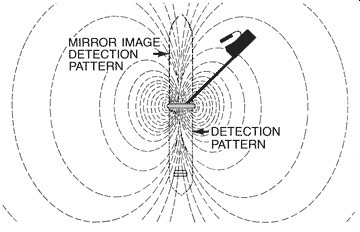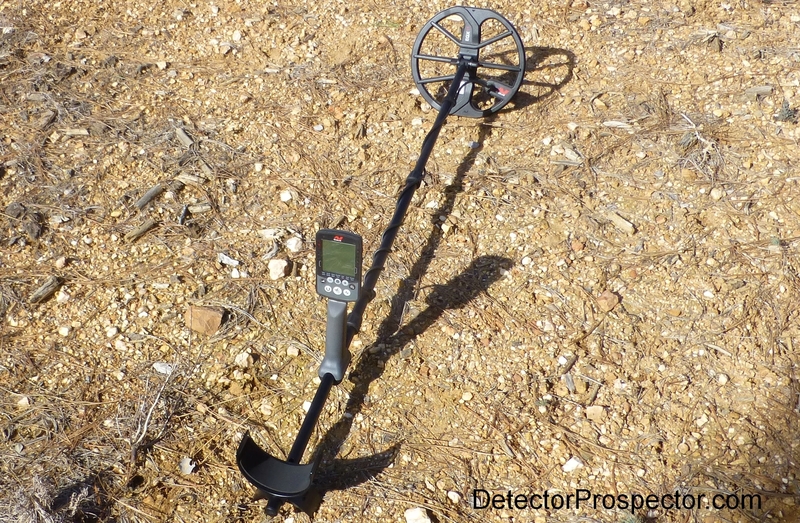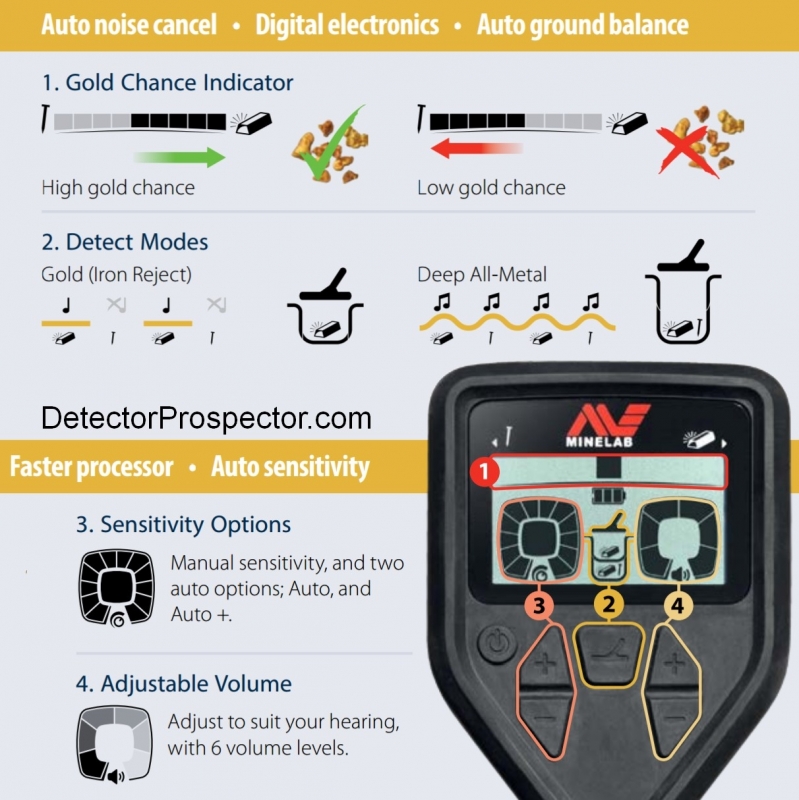-
Posts
19,755 -
Joined
Content Type
Forums
Detector Prospector Home
Detector Database
Downloads
Everything posted by Steve Herschbach
-
Love the dime - congratulations!
-

Nuggets On Bedrock Or Not?
Steve Herschbach replied to Rob Allison's topic in Detector Prospector Forum
In desert locations surface deflation puts the nuggets at or near surface. In any instance dealing with running water however bedrock is a great place to be. Very nice find Rob! -
Sad to see a couple older forums closing. The excuse tends to be social media but this forums rapid growth says there is more to it than that. In any case, MyTreasureSpot is closing by the end of the month. And Treasure Depot sometime in June.
-

Extending Pickup Head Cable
Steve Herschbach replied to K4PI Mike's topic in Metal Detector Advice & Comparisons
I’ve seen extensions up to three feet on VLF detectors, but 25 feet? I have to think it would change the target id numbers at least, but if all you want to do is get a signal it may work. For $20 if it was me I’d JW go for it and see what happens. -
When I think about it I always go out looking for a certain thing, and funny story is I find what I look for more often than not. If I want to find large gold nuggets I have to pick machines, coils, and locations that favor large gold nuggets. If I chase small gold nuggets, it’s a different gig, and indeed that is what I then tend to find. Or I am hunting normal jewelry, or I’m hunting micro jewelry. Or silver coins. In each case I’m focused on a certain type target and location, machine, coil, tuning, and mind set are all aimed at that target. I’m almost never just out detecting for any old thing that comes along. That’s what I love about Equinox, not that it is perfect at finding everything at once, but that it can be optimized to do extremely well at so many different type detecting scenarios.
- 7 replies
-
- minelab equinox
- research
-
(and 1 more)
Tagged with:
-

1st Detector For Sierra / Reno Area
Steve Herschbach replied to ketchneddy's topic in Metal Detector Advice & Comparisons
If you can afford a Multi Kruzer you can afford an Equinox 600... my recommendation. Otherwise a Vanquish assuming gold prospecting is fairly low on you list of desires. If you are thinking more like gold prospecting on a budget, take a look at the Bounty Hunter Time Ranger Pro. -
All detector tuning for me is just signal balance. Ground, EMI, high conductors, low conductors, ferrous targets, non-ferrous targets, large targets, small targets. Unfortunately optimizing for one desired target often enhances the signal from an undesired target. So how do I optimize the desired target as much as possible while suppressing undesired targets as much as possible? The modes for me range from “hot” to “least hot” as shown below. Most sensitive to small signals, hot rocks, EMI, signals from salt/alkali conditions. Most sensitive to very small targets like gold nuggets; max depth on all targets under perfect conditions. Under poor conditions, increase in noise to target signal ratio can work against target definition. 1. Gold Modes 2. Park & Field Mode 2 3. Park & Field Mode 1 4. Beach Mode 1 5. Beach Mode 2 Least sensitive to small signals, hot rocks, EMI, signals from salt/alkali conditions. Less sensitive to very small targets, some depth sacrifice on all targets under perfect conditions. However, under poor conditions improved target signal to noise ratio can enhance target definition. Each mode gives me a starting point I can work from, fine tuning by varying every available setting, including single frequencies. I find most coin and jewelry type detecting to be relatively simple... it is gold prospecting in bad ground that challenges me and makes me really use all the options available. My nugget tuning tips illustrate how I use every option on the machine to deal with the issues I encounter while nugget detecting. I have notes on every setting there that explains my thinking on them. I can imagine a scenario where I would be using any mode including Beach modes while nugget detecting, and single frequency options can be a lifesaver dealing with certain hot rocks. The same in theory applies to any type of detecting... I might use any mode for any type of detecting under unusual circumstances. For most other detecting however I’m not looking for quite the edge I need for chasing gold nuggets in extreme mineral conditions. So for most coin and jewelry detecting Park 1 is my favorite base to to work from, unless on saltwater beaches, then beach modes. No matter where or how I detect I do not like a totally quiet machine and so my tuning just automatically chases the edge of where noise bleeds through from the ground or EMI or whatever. It’s a little hard to describe how I get there but I’m always riding the ragged edge. Generally 50 tones wide open for full feedback with disc employed visually as a “small item filter.” I’m very shy of any iron bias at all, preferring to keep it at zero under most circumstances. After all that though other than nugget detecting I really don’t obsess over settings much, as in my world hours and location plus getting the coil over the target matter more than some mystical magical settings. I’ll often just grab the Equinox and run close to stock settings, just going to 50 tones and bumping the gain up if a can, and go detecting. The stock settings are some of the best on any machine and the biggest mistake beginners make is messing with Equinox settings not understanding what they are doing.
- 7 replies
-
- minelab equinox
- research
-
(and 1 more)
Tagged with:
-

Coiltek Coils For SDC 2300 On Sale
Steve Herschbach replied to Steve Herschbach's topic in Minelab Metal Detectors
What the electromagnetic field with lines of force looks like and what the detection area or pattern is and looks like are two different things. The electromagnetic field looks like a donut as illustrated in the Garrett diagrams. The detection area/pattern is more like a half bowl beneath the coil or a basketball around the entire coil. You have to keep your terminology straight when talking detectors as lots of times people are talking two different things. Larger coil sizes expand the electromagnetic field. A larger coil will make the detection area larger for a large item, and smaller for a small item. As far as the rest, you either have an ear for faint targets or you don’t. No matter what you do with a detector, there are always barely discernible targets. Enhance those somehow to be louder, and now a new class of faint targets appear. There will always be people who hear and are willing to investigate whispers that others pass up. -
https://www.detectorprospector.com/forums/topic/8906-high-number-war-nickel/ https://www.detectorprospector.com/forums/topic/6576-what-vdi-are-your-buffs-v-nics-coming-in-at/
-

Coiltek Coils For SDC 2300 On Sale
Steve Herschbach replied to Steve Herschbach's topic in Minelab Metal Detectors
Hi Mitchel, I have noticed you have an interest in “fringe areas” as relates to metal detector coils. They are nothing new, a very old concept, and simply mean the edges of the detection field where targets get weak. Borderline target area, nothing more complex than that. The fringe area is like a rind around the main detection area/pattern where strong targets fade into nothingness. Where do you want to draw the line based on what size target? Drawings are just illustrating principles, not reality. The electromagnetic field extends many feet in all directions, and in reality is more like a huge donut extending into infinity. If you wanted to try and be accurate you at the least have to define the target size. The detection area is not fixed in size, but varies with every target. For a car size object the illustration might show a detection field reaching 6 feet in all directions. Pictures like the one I posted are showing something more based on a small target, dime size or smaller. For a single post ear ring or tiny nugget the detection pattern may be smaller than a teacup. The DD “blade” diagrams in particular tend to be marketing nonsense. The blade effect is an artifact of the audio processing and completely misrepresents what the actual electromagnetic field looks like and the effect the target is having while under the windings. If the blade effect were true, a trash target under one edge of a DD coil would have no effect on the detection of a target under the center of a coil, and they most certainly do. Half what most people believe about coils is colored by marketing nonsense. This old Garrett article from 40 years ago is more accurate than most anything else published since, and discusses fringe area targets among other things. Anybody with a metal detector in their hands can answer these questions for themselves in minutes bench testing with various size targets. -

Coiltek Coils For SDC 2300 On Sale
Steve Herschbach replied to Steve Herschbach's topic in Minelab Metal Detectors
Pulse induction mono coil, completely different beast, can’t be made to run on any VLF. Mono coils and concentric get confused. A mono coil has one winding that alternates between transmit and receive (pulse). A concentric is two coils one within the other (aligned concentrically) with one transmitting and one receiving on a continuous basis (continuous wave / induction balance... also referred to as VLF). Metal detector coil types illustrated - concentric vs DD vs mono https://www.detectorprospector.com/forums/topic/597-vlf-concentric-vs-dd-coils/ -

Exciting Times For New Detectors
Steve Herschbach replied to maxxkatt's topic in Metal Detector Advice & Comparisons
Early 1990’s was when we really got a lot of machines that were so good that most still perform well by today’s standards. In fact a few of them are still in production. What’s different now is more about a drastic resetting in how much power you can get at lower prices, along with some technical innovation. For a long time metal detectors were resistant to serious competition driving down prices, and in fact the high end machines kept getting ever more expensive. The $2500 CTX 3030 and $10,000 GPZ 7000 (when released, now “only” $7999) set the high water mark that has hopefully been reversed. -

Coiltek Coils For SDC 2300 On Sale
Steve Herschbach replied to Steve Herschbach's topic in Minelab Metal Detectors
There is that pesky chip.... -

Custom Waterproof V3i
Steve Herschbach replied to Steve Herschbach's topic in White's Metal Detectors
The video is from April 2018 so in two years the answer has been no. I’d rather see a V3i in the MX Sport housing but wish in one hand.... -

Equinox 800 For Gold? How Stupid....
Steve Herschbach replied to Gerry in Idaho's topic in Detector Prospector Forum
This is why I ditched all my other VLF nugget machines. The only other one I have that I use is the 24K because it can run off batteries for situations where charging is less than convenient, has better ergonomics than the Equinox, but mainly better coils for prospecting, including a concentric coil option. It’s a great little scrubber. Minelabs refusal to make a solid 6”x10” coil for the Equinox is particularly irritating given its strength as a gold prospecting detector. The Equinox/24K combo leaves me lacking for nothing when it comes to VLF gold prospecting. It’s a push on small gold between the two but I’d give the 24K the nod there if pressed on the matter. Depth on large gold - Equinox, hands down. It was apparent to me back when prototype testing that the Equinox was a superior gold prospecting detector, even with coils that are not optimized for that purpose. However, I decided to not push that aspect of the machine very hard. Partly for the reason that Gerry mentions, but also because many prospectors are set in their ways, and Equinox is a different beast requiring some out of box thinking and willingness to experiment to really get the best out of it as a gold prospecting unit. I was getting enough guff at the time over shilling for Minelab that outside of offering some tips I decided to just lay low on this aspect of the machine. Prospectors can be a pretty harsh bunch if they think you are pushing something off on them. But yeah, Equinox, Multi-IQ, gold nuggets... 👍🏼 Minelab Equinox in Sierra Nevada gold country -
This guy did a beautiful job waterproofing the V3i.
-
I am not sure if anyone else is doing this (it appears to be a Coiltek sale but no mention on their website), but Chris at AZO is advertising Coiltek coils for the Minelab SDC 2300 at 20% off for the rest of the month or while supplies last. 20% OFF the following premium Coiltek products:• 10x5 Gold Extreme: WAS $295 - NOW $236• 11" Gold Extreme: WAS $315 - NOW $252• 14x9" Gold Extreme: WAS $315 - NOW $252• Gold Extreme SDC Accessory Pack: WAS $67 - NOW $54 http://arizonaoutback.ipbhost.com/topic/14510-coiltek-isolation-special-new/ https://www.coiltek.com.au/coils/gold-extreme/
-
Welcome to the forum! The only stupid questions are the ones that go unasked. There is nothing magical about metal detecting, just pick a decent spot, dig stuff, and use proper techniques for leaving no trace i.e. carefully filling holes, even in the middle of nowhere. The way you learn is to go do it and pay attention while digging stuff. No magic settings required - use the recommended settings in your manual to get started. Location and patience matter more than anything. Finally, in a lot of ground in Nevada or California you may only get half the depth people back east talk about due to higher ground iron mineral content. Do not expect 10” dimes, more like 5” - 8” at best. Good luck!
-

Avoid Digging Aluminum Trash
Steve Herschbach replied to Jeff McClendon's topic in XP Metal Detectors
Some great commentary here. I’ll keep mine short and just say thank you to people who leave “aluminum” in the ground! -
I totally agree with that!
-

Minelab 1000 Coil Detection
Steve Herschbach replied to flycatch's topic in Metal Detector Advice & Comparisons
That is not uncommon with the Gold Monster using the discrimination mode, and a good reason for not using the discrimination mode. I always used all metal and if I wanted discrimination relied on the meter readings. You also get far better depth in all metal mode. -

Coil Swap For My TDI Beach Hunter
Steve Herschbach replied to Tony's topic in White's Metal Detectors
The dual field is a mono coil within a mono coil; nothing changes about the operation of the detector. The theory of the dual field coil is you get the depth of a large coil with the small item sensitivity of a small coil. However, you are exposing more windings to the environment.... soil, saltwater.... and so you get more ground or saltwater feedback than you do with a plain mono coil. The TDI Pro Oz series shipped with plain mono “Aussie” coils because of this. The standard TDI dual field coils were hot enough to be problematic on a lot of Australian ground. Eric Foster developed the TDI circuit originally for beach detecting, and he thought an 11” round mono was an optimum coil size for beach detecting. As a ring hunter I would personally prefer an 10” - 12” plain mono coil over the dual field coil on a TDI Beachhunter. This would minimize saltwater effects while providing optimum depth on gold rings. You would lose some sensitivity to small items like pendants, ear rings, and chains compared to the dual field. -

Whites TDI SL Battery Questions
Steve Herschbach replied to newbie2020's topic in White's Metal Detectors
Any SD or GP model is considered “obsolete” by Minelab with minimal to no service available. Best stick with any GPX models if buying used. -
I’m big on pictures and people often have no idea what a post is talking about when there are none, so I take the liberty of adding them from time to time. I have easy access to most photos so it only takes me a couple minutes.
-
Checking around it seems there are few Equinox for sale used right now, a little surprising since there are some people out there in need of bucks. You would think with so many sold the last couple years more would be coming up used, but that does not appear to be the case. I also saw under the eBay “Sold” listings a lot of control pod only sales out of the Russian Federation. That seems a bit odd to me. What happened to the rest of the detector? Minelab does not seem to sell the pod only, so I have to question how legit those things are.





